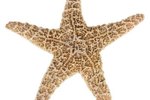Despite the diversity within the jellyfish clade, Medusozoa, all 200 described jellyfish species exhibit radial symmetry. This means that their appendages radiate outward from a central point – akin to the spokes of a bicycle wheel. They have a distinct top and bottom, but they do not have a left side or right side, as bilateral animals do.
Radially Symmetric Organisms
Jellyfish are not the only example of radially symmetric organisms in the world. In fact, most members of the phylum to which jellyfish belong, Cnidaria, exhibit radial symmetry, including most hydras, corals and sea anemones. The only other animals with this type of symmetry are echinoderms -- a group that includes sea urchins, starfish, sand dollars and sea cucumbers. Radial symmetry is likely the primitive type of symmetry for almost all living species except a few primitive lineages, such as sponges.
Nevertheless, radial symmetry is not restricted to the animal kingdom. Some flowers, for example, exhibit the pattern as well. Although scientists debate whether they are truly living organisms, some viruses exhibit radial symmetry as well.
Other Types of Symmetry
Organisms exhibit several other types of symmetry, including bilateral symmetry, spherical symmetry and asymmetry. Bilateral symmetry, the most familiar type, describes animals with distinct left and right halves. Humans, dogs, cats, sharks, snakes, elephants and most other vertebrates are bilaterally symmetrical. Ticks, spiders, insects, crustaceans and numerous other invertebrates also bear left and right halves.
Spherical symmetry, which describes ball-shaped organisms, is common among several types of algae. Asymmetric organisms lack symmetry entirely. Sponges are one group of asymmetrical animals, as are adult flatfish. However, as larvae, flatfish exhibit bilateral symmetry.
Salvaging Symmetry
Despite the painful sting most jellyfish are capable of delivering, they have no shortage of predators in the open ocean, and many jellyfish end up as meals for sea turtles and sharks. Those who escape predatory attacks often lose tentacles in the process, which inhibits their locomotor and feeding abilities. However, scientists with the California Institute of Technology, the University of Oxford, and Academia Sinica in Taiwan discovered that some jellyfish repair themselves.
Publishing their results in a 2015 issue of the "Proceedings of the National Academy of Sciences of the United States", the team, led by Michael J. Abrams of Cal Tech, dubbed the phenomenon symmetrization. They observed that some moon jellies (Aurelia aurita) who were missing tentacles reorganized their bodies to restore symmetry. The jellies did not produce new arms; rather, they moved their existing arms away from each other until they had once again become symmetrical.





